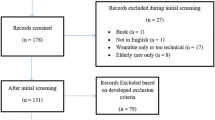Abstract
The Wearable Computer Project is a testbed integrating research on rapid design and prototyping. Based on representative examples from six generations of wearable computers, the paper focuses on the differences in rapid prototyping using custom design versus off-the-shelf components. The attributes characterizing these two design styles are defined and illustrated by experimental measurements. The off-the-shelf approach required ten times the overhead, 30% more cost, fifty times the storage resources, 20% more effort, five times more power, but 30% less effort to port software than the embedded approach. An evaluation of the VuMan 3 design is presented to show its superior advantages in comparison to the off-the-shelf approach.
Similar content being viewed by others
References
J. Akella, A. Dutoit, and D.P. Siewiorek, “Concurrent engineering: A prototyping case study,” in Proc. 3rd IEEE International Workshop on Rapid System Prototyping Research, Triangle Park, N. Carolina, June 1992.
A. Smailagic and D.P. Siewiorek, “A case study in embedded systems design: The VuMan 2 wearable computer,” IEEE Design and Test of Computers 10(3): 56–67, September 1993.
D.P. Siewiorek, A. Smailagic, J.C.Y. Lee, and A.R.A. Tabatabai, “Interdisciplinary concurrent design methodology as applied to the navigator wearable computer system,” Journal of Computer and Software Engineering 2(3): 259–292, 1994.
A. Smailagic and D.P. Siewiorek, “Modalities of interaction with CMU wearable computers,” IEEE Personal Communications 3(1): 14–25, February 1996.
S. Finger, M. Terk, F. Prinz, D.P. Siewiorek, A. Smailagic, J. Stivoric, and E. Subrahmanian, “Rapid design and manufacture of wearable computers,”Communications of the ACM 39(2), February 1996.
A. Smailagic, D.P. Siewiorek, D. Anderson, C. Kasabach, T. Martin, and J. Stivoric, “Benchmarking an interdisciplinary concurrent design methodology for electronic/mechanical systems,” in Proc. ACM/IEEE Design Automation Conference, pp. 514–519, San Francisco, CA, June 1995.
A. Smailagic, D.P. Siewiorek, R. Martin, and J. Stivoric, “Very rapid prototyping of wearable computers: A case study of custom versus off-the-shelf design methodologies,” in Proc. ACM/IEEE Design Automation Conference, pp. 315–321, Anaheim, CA, June 1997.
A. Becker, “High resolution virtual displays,” in Proc. SPIE, Vol. 1664, Society of Photooptical Instrumentation Engineers, Bellingham, WA, 1992.
K.F. Li, H.W. Hon, M.J. Hwang, and R. Reddy, “The sphinx speech recognition system,” in Proc. IEEE ICASSP, Glasgow, UK, May 1989.
R. Rashid et al. “Mach: A system software kernel,” COMPCON Spring '89, San Francisco, CA, March 1989.
MIT X Consortium, X Window System, Version 11, Release 5, MIT Laboratory of Computer Science, Cambridge, MA, 1990.
T. Martin, “Evaluation and reduction of power consumption in the navigator wearable computer,” Masters Thesis, Report 1-18-94, EDRC, Carnegie Mellon University, July 1994.
A. Smailagic and J. Stivoric, “The cost and suppliers for wearable computers,” Engineering Design Research Center Document, Carnegie Mellon University, July 1994.
F. Chamberlain, “Secondary storage for wearable computers,” Masters Thesis, Report 2-18-94, EDRC, Carnegie Mellon University, July 1994.
Author information
Authors and Affiliations
Rights and permissions
About this article
Cite this article
Smailagic, A., Siewiorek, D.P., Martin, R. et al. Very Rapid Prototyping of Wearable Computers: A Case Study of VuMan 3 Custom versus Off-the-Shelf Design Methodologies. Design Automation for Embedded Systems 3, 219–232 (1998). https://doi.org/10.1023/A:1008850609458
Issue Date:
DOI: https://doi.org/10.1023/A:1008850609458




